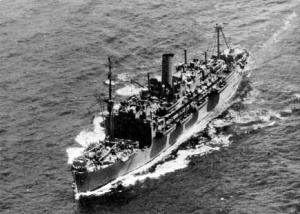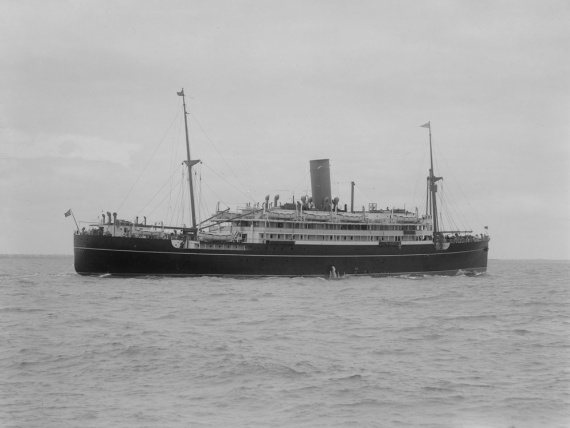HMAS Westralia (I)
| Type |
Armed Merchant Cruiser/Landing Ship Infantry |
|---|---|
| Pennant |
F95 |
| Builder |
Harland and Wolff Ltd, Glasgow, Scotland |
| Commissioned |
17 January 1940 |
| Decommissioned |
19 September 1946 |
| Dimensions & Displacement | |
| Displacement |
|
| Length | 445 feet |
| Beam | 60 feet |
| Draught | 22 feet 6.5 inches |
| Performance | |
| Speed | 14 knots |
| Complement | |
| Crew | 541 |
| Propulsion | |
| Machinery | 2 Harland and Wolff oil engines |
| Horsepower | 1750 |
| Armament | |
| Guns |
|
| Awards | |
| Battle Honours | |
The twin screw motor vessel Westralia (I) was built for Huddart Parker Ltd. Following the declaration of war she was requisitioned for war service as an Armed Merchant Cruiser on 2 November 1939 and commissioned as HMAS Westralia (I) at Sydney on 17 January 1940 under the command of Commander Alvord Sydney Rosenthal RAN.
Westralia (I) began operational service on 30 March 1940 when she departed Sydney for Darwin and thence to Macassar. April was spent in East Indian waters on patrol. One ship, the Norwegian Fernlane was intercepted and sent in prize to Singapore.
On 3 May 1940 Westralia (I) returned to Darwin and remained exercising in the area for most of the month before proceeding to Fremantle, where she arrived on 29 May. On 1 June she proceeded to rendezvous with SS Largs Bay in the Indian Ocean, both ships reaching Fremantle on 4 June. Further escort duty from Fremantle occupied the cruiser until 11 June when she entered harbour and remained berthed for fifteen days. Stores and provisions for four months were embarked and necessary refitting undertaken.
On 25 June Westralia (I) departed Fremantle for Colombo to begin a period of patrol and escort duties on the East Indies Station, which was to last until January 1941. It was uneventful routine service over a large area of sea similar to that performed by HMAS Kanimbla (I) and covered the whole of the northern and western areas of the Indian Ocean from Sumatra to Bombay and South to Mauritius.
On 23 December 1940 Westralia (I) made her final departure from Colombo, detached from the East Indies Station and proceeded for Fremantle. On 11 January 1941 she returned to Sydney after an absence of ten months.
Following a fortnight in harbour she sailed for Darwin escorting Zealandia, arriving on 5 February. The remainder of the month was spent assisting in carrying out an aerial survey of the Admiralty Gulf area. At the close of the month she returned to Sydney.
The first days of March 1941 found Westralia (I) at sea escorting a convoy for New Zealand. Returning to Sydney on 6 March, she commenced a month’s refit at Garden Island. April and most of May 1941 were spent on shipping protection at Nauru and Ocean Island and after a brief stay in Sydney she escorted a convoy for New Zealand, returning to Sydney on 29 June.
In July the cruiser was back at Nauru and Ocean Island evacuating civilians and arranging a demolition programme. She returned to the two islands again in August, landing relief garrisons and fixing demolition charges.
The first three weeks of September 1941 were spent at Garden Island making good defects, before proceeding for Darwin on 29 September escorting a floating dock. The remainder of the year was spent transporting troops to Timor and New Guinea and patrolling in the Darwin area.
On 10 January 1942 Westralia (I) arrived in Sydney from Port Moresby to commence refit. The work was completed on 18 February following a break of seven days for convoy escort duty. The remainder of February was occupied covering conveys on the Queensland coast.
When nearing Sydney on 31 May 1942 a Japanese submarine was sighted. The USS Chicago, which was in company, opened fire but the submarine dived and was not seen again. This was just before the midget submarine attack on Sydney Harbour.
The rest of Westralia (I)’s active career as an Armed Merchant Cruiser was spent almost continuously on convoy protection duty, ending in August 1942 when she formed part of the escort for Convoy ZK12 from Fremantle to Sydney. In the intervening period of March to August 1942, in addition to coastal convoy protection she escorted shipping to South Pacific waters.
In September 1942 she proceeded to Port Stephens and after assisting with the placing of anti-torpedo nets at that port, became a temporary Accommodation Ship for HMAS Assault, the Naval Training School for Combined Operations training at Port Stephens.
In December she berthed at Sydney, bringing her career as an Armed Merchant Cruiser to a close. Between 9 February and 25 June 1943 Westralia (I) was undergoing conversion to a Landing Ship Infantry at Sydney. A period of training exercises at Port Stephens followed before she began operations transporting United States Marines to Goodenough Island in September. The remainder of the year was spent in landing exercises and transport of troops to Goodenough Island and the operations at Arawe, New Britain.
In January 1944 Westralia (I) landed United States troops at Cape Cretin (New Guinea). En route from the area on 28 January she was attacked by Japanese aircraft and suffered casualties and damage which was, fortunately, insufficient to put her out of commission.
On 5 February she was back at Cape Cretin with reinforcements. March and April were spent operating in New Guinea waters including the landings at Hollandia. Westralia (I) returned to Sydney on 31 May 1944 for refitting.
In July she again began transporting troops to the forward areas operating from New Guinea bases. August was spent mainly in the Solomons on training exercises, followed by similar duties in the Aitape (New Guinea) area in September. In October 1944 Westralia (I) took part in the landings at Leyte Gulf in the Philippines.
Westralia (I) spent December in the Solomons and at Manus before returning to the Philippines for the Lingayen landings in January 1945. There she experienced an attempted kamikaze attack by a Japanese aircraft. Only minor damage was sustained.
Westralia (I) returned to Australia in March 1945. In Brisbane a fire in her holds delayed her for ten days. On the last day of the month she sailed for Manus preparatory to taking part in operations in Borneo. The landings at Balikpapan in July 1945 ended Westralia (I)’s part in transporting troops to areas in enemy hands and from then until the end of hostilities she was engaged in carrying troops and stores to the Solomons and New Guinea areas.
In the post war period Westralia (I) was engaged in the repatriation of troops from the island areas north of Australia to the mainland. She paid off at Sydney on 19 September 1946 after steaming 120,978 miles in naval service. After work on restoring the ship to her peacetime condition had been in progress for some months a requirement arose for Westralia (I) to maintain a service between Sydney and Kure, Japan, for the British Commonwealth Occupation Forces. This occupied her from December 1947 until April 1949. She did not recommission as an HMA Ship and was manned by a Merchant Navy crew.
Reconditioning was recommenced but was again interrupted when the ship was chartered to the British Ministry of Transport for use as a Troop Carrier. Westralia (I) left Sydney in August 1949 and after service in the Mediterranean returned to Sydney in March 1950. Reconversion for peacetime service was again begun and on 27 March 1951 Westralia (I) was returned to her owners.
Westralia (I) served as an Australian interstate passenger vessel until February 1959 when she made her last trip between ports from her home port of Melbourne. After lying at Sydney for some months, she was sold to the Asian and Pacific Shipping Co Ltd, Suva, Fiji. The company renamed her Delfino in 1959 and converted her to a livestock carrier for trade with the United States. Later the ship was renamed Woolambi. On 19 December 1961 she left Sydney under tow by the Japanese tug Nisso Maru to be broken up in Japan.











